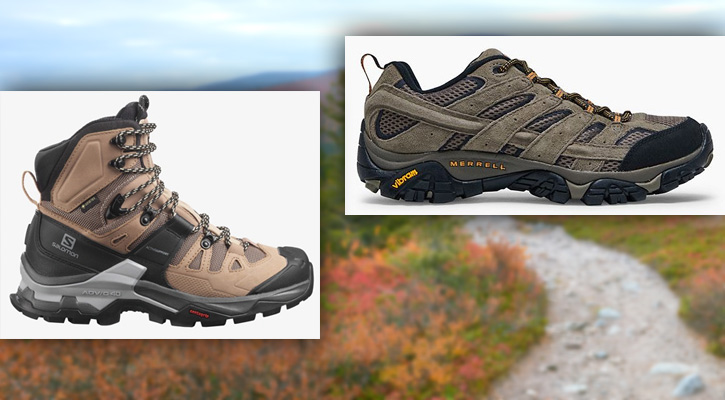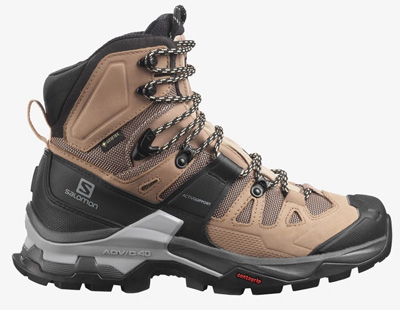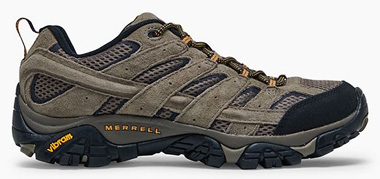
Hiking boots and shoes often come with a hefty price tag, a factor that reflects their specialized design and the technology incorporated into their creation.
When you invest in a pair of hiking footwear, you’re paying for the research and development that goes into providing support, durability, and protection for your feet over challenging terrain.
Manufacturers use high-quality materials and construction techniques that are meant to withstand harsh conditions and prolonged use, which contributes to the overall cost.
What sets hiking boots and shoes apart from regular footwear is their ability to navigate outdoor landscapes while preserving foot health. They are engineered with features like water-resistant or waterproof materials, enhanced traction soles, and supportive structures that are tailor-made for hiking trails.
These features are essential for a safe and comfortable outdoor experience, but they also add to the manufacturing complexity and, subsequently, the cost.
Purchasing hiking footwear is an investment in your outdoor adventures. The equipment you choose can significantly impact your comfort and performance on the trail, thus justifying the expense.
While the upfront cost might seem considerable, quality hiking boots or shoes can last for many seasons, making them a worthwhile long-term purchase if you’re a serious hiker.
1. Why is Hiking Footwear so Expensive?
When you invest in hiking boots or shoes, you’re paying for specialized design and durable materials. Manufacturers use high-quality leather or synthetic materials that can withstand the wear and tear of the trail. These materials are also designed to offer protection against water, rocks, and other trail hazards.
Another factor contributing to the cost is the advanced technology. Modern hiking footwear includes features such as:
- Vibram soles for superior grip
- EVA or polyurethane midsoles for cushioning
- Breathable, waterproof membranes like Gore-Tex
These technologies require significant research and development, which in turn increases production costs.
Labor and quality control are also key factors. Many hiking boots and shoes are made with an attention to detail that can require skilled craftsmanship. To ensure your safety and comfort on uneven terrain, brands employ strict quality control measures, further driving up the price.
Lastly, consider the brand’s reputation and warranty. You often pay more for brands with a proven track record of reliability and customer service. A good warranty can add value by protecting your purchase in case of defects.
Your investment in hiking footwear goes towards materials, technology, labor, and the peace of mind that your feet are well-protected on the trail.
Read also: 9 High-End, Expensive Hiking Brands for Clothing and Footwear

Salomon Women’s Quest 4 GORE-TEX Hiking Boots: image salomon.com
2. Anatomy of Hiking Boots and Shoes
Hiking boots and shoes are designed with specialized features for durability, comfort, and safety. The components used in their construction have a direct impact on performance and price.
Materials and Design
The materials chosen in hiking footwear affect its weight, breathability, and waterproofing capabilities. High-quality hiking boots typically involve full-grain leather, suede, or nubuck leather, known for their durability and resistance to wear.
Advanced synthetics such as Gore-Tex serve as a waterproof membrane to keep your feet dry while allowing sweat to escape, maintaining a breathable design.
- Upper: The upper part is often made of leather or synthetic materials that offer protection and durability.
- Leather: Conveys a classic look and natural resistance to elements.
- Synthetics: Usually lightweight and dry quicker than leather.
- Design: Strategic stitching and paneling contribute to support, particularly around the ankle, and can include padded collars for extra comfort.
Support and Protection
Your hiking boots provide essential support and protection against rough terrain.
- Ankle Support: High tops on many boots prevent ankle rolling and injuries.
- Midsole: The midsole, made of EVA foam or polyurethane, provides cushioning and absorbs shock.
- EVA: Typically lighter, softer, and used in most modern hiking shoes.
- Polyurethane: More durable and suited for rugged terrain.
- Plates: Thin, semiflexible inserts between the midsole and the outsole that protect the feet from getting bruised by uneven rocks and roots.
- Shanks: These 3 to 5-inch inserts add load-bearing stability to the midsole.
Traction and Stability
Traction and stability are critical for navigating various terrains safely.
- Outsole: Made of rubber for toughness, the outsole features a lug pattern that provides grip on different surfaces.
- Lug Pattern: Deeper and thicker lugs are used for rugged terrain, while denser patterns increase traction on rock.
- Rand: A rubber layer that wraps over the toe and sometimes around the entire boot for extra protection and stability on rocky terrain.
- Sole Construction: The soles are often reinforced for heavy-duty construction not found in regular shoes, enhancing both stability and durability.
- Materials: Softer rubber soles improve grip, while harder rubber lasts longer.
Must read: 7 German Hiking Boot Brands: Our Top Picks

Merrell Men’s Moab 2 Ventilator Hiking Shoes: image merrell.com
3. Manufacturing and Quality Assurance
The production of hiking footwear involves precise craftsmanship and rigorous testing to ensure that you receive a product capable of withstanding the demands of outdoor adventure, maintaining comfort, and prioritizing foot safety on varying trails.
Craftsmanship and Durability
High-quality hiking boots and shoes are constructed with superior craftsmanship to meet your durability expectations. Materials like full-grain leather, known for its tough and water-resistant properties, are commonly used.
The design process incorporates research and development to enhance the performance and reliability of the footwear. Features such as strengthened midsoles provide stability and support for your feet, essential for backpacking boots.
- Materials: Only high-grade materials are chosen for reliability.
- Leather: Provides toughness and water resistance.
- Synthetic fabrics: Offer breathability and quicker drying capabilities.
Testing and Standards
Your hiking boots undergo extensive testing to meet strict standards before they hit the market. This ensures their quality, performance, and reliability across different environments.
Tests simulate extended use across harsh terrains, assessing durability and the effectiveness of waterproof designs. The comfort of the shoes during actual hiking conditions is evaluated to guarantee a blissful experience for your feet.
- Testing Regimens:
- Durability tests: Simulate prolonged use on rugged trails.
- Waterproofing checks: Ensure feet stay dry in wet conditions.
- Standards Compliance:
- Performance metrics: Benchmarked against industry standards.
- Quality checks: Multiple inspection points during manufacturing.
Don’t miss: 10 Best Italian Hiking Boot Brands
4. Pricing and Value
When considering the purchase of hiking boots, it’s essential to understand that their cost is often reflective of the value provided in terms of materials, construction, and research.
Price tags are not arbitrary, and determining whether the investment aligns with your budget calls for an appreciation of the various contributing factors.
Materials and Construction Costs
Materials like high-grade leather and advanced synthetic fabrics are commonly used in quality boots, contributing to the overall retail price. Hiking boots require a blend of durability, comfort, and weather resistance, which raises the cost of materials.
In addition, the construction process may involve specialized labor and multiple stages of quality control, further increasing expenses.
- Leather: Higher cost due to quality and treatment for durability.
- Synthetic materials: May involve expensive technology (Gore-Tex membranes) for breathability and waterproofing.
Research, Development, and Marketing
Before hiking boots hit the shelves, substantial investment goes into their research and design features. This encompasses everything from ergonomic studies to the trial of new materials.
Following development, marketing strategies, including advertising and athlete endorsements, play a crucial role in introducing the product to your attention but add to the cost.
- Research: Significant funding for ergonomic and material innovation.
- Marketing: Includes advertising, endorsements, and promotional events.
The True Cost of Hiking Footwear
Balancing the scales between cost and value, expensive hiking boots are often seen as an investment. They are designed to endure challenging trails and provide support over time, potentially saving money in the long run.
The quality boots employ a complex assembly with expensive materials and extensive R&D, justifying the higher price compared to regular footwear.
- Investment: Long-term durability may negate the need for frequent replacements.
- Balance: The initial higher cost is offset by longevity and performance.
Read next: 5 Best French Hiking Boots and Shoe Brands
5. Comparisons with Other Footwear
When considering the expense of hiking boots and shoes, it’s important to examine how they differ from standard footwear like sneakers or casual shoes, particularly in their design and intended use.
Difference in Specifications
Hiking boots are crafted with durable materials that are typically more costly than those used for everyday shoes. For instance, reinforced leather or advanced synthetic materials provide abrasion resistance and durability.
The soles of hiking boots are engineered with deep lugs for increased grip on rough and uneven terrain, which is quite distinct from the flatter soles found on most sneakers or dress shoes.
- Protection: Your hiking boots shield your feet from sharp rocks, roots, and uneven ground, which is a level of protection that regular sneakers don’t offer.
- Weather-Resistance: Hiking boots often include waterproof features, ensuring your feet stay dry when crossing streams or when caught in rain, unlike standard shoes that may not have these weatherproofing traits.
- Ankle Support: With a focus on ankle protection, hiking boots provide support to prevent injuries such as sprains that can be common on unstable surfaces.
The Importance of Specificity for Hiking
When you choose hiking footwear, you’re selecting a shoe designed for performance in specific conditions. This contrasts with general-purpose footwear, which doesn’t offer the same specializations.
- Comfort and Balance: Properly designed hiking boots or shoes ensure balance and comfort during long treks, which is vital when you’re miles away from any help.
- Specialized for Activity: Whether you’re backpacking with a heavy load or on a simple day hike, hiking shoes and boots are fine-tuned for the activity, something that casual sneakers or trail runners might not be.
- Prevention of Blisters and Injuries: Choosing the right hiking footwear helps prevent blisters and foot injuries by accommodating the elements and rigors of trail hiking, as opposed to other types of shoes that prioritize fashion or casual use over function.
Buying hiking boots or shoes is an investment in quality and your safety on the trails. The expense reflects the specialized technology and materials that go into creating footwear that can withstand the challenges of the outdoors while keeping you comfortable, protected, and lightweight on your feet.
Read next: 8 European Hiking Boots and Shoes Brands: Our Top Picks
